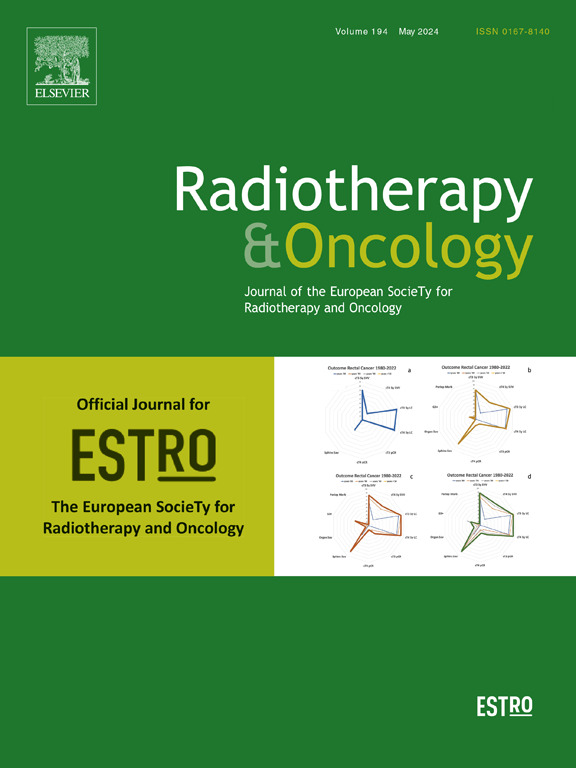女性生殖器肿瘤患者放疗后发生继发性盆腔肿瘤的风险和生存结果:大型人群队列研究。
IF 4.9
1区 医学
Q1 ONCOLOGY
引用次数: 0
摘要
背景和目的:研究放疗(RT)对继发性盆腔肿瘤(SPN)风险的影响,以及女性生殖器肿瘤(FGN)患者确诊后的生存结果:本研究利用 SEER 数据库,涉及九个肿瘤中心的 102,895 名患者,时间跨度为 1990 年至 2015 年。我们采用Fine-Gray竞争风险回归法绘制了SPN的发展轨迹,并使用Kaplan-Meier法计算了10年总生存率:该研究共纳入25774名RT组患者和77121名非放疗(NRT)组患者。RT组的SPN累积发病率为5.10%,NRT组为3.42%。RT 组的膀胱癌发病率明显更高(调整后危险比 [HR]:1.75; 95 % 置信区间 [CI]:1.43-2.14; P 结论:RT被认为是FGN患者罹患SPN的独立风险因素。接受 RT 治疗的 FGN 患者罹患继发性肿瘤(尤其是膀胱癌)的风险显著增加,10 年生存率也有所下降。本文章由计算机程序翻译,如有差异,请以英文原文为准。
Risk and survival outcomes of secondary pelvic neoplasm after radiotherapy in female patients with genital neoplasms: A large Population-Based cohort study
Background and purpose
To investigate the impact of radiotherapy (RT) on the risk of secondary pelvic neoplasms (SPN) and the survival outcomes of patients following a diagnosis of female patients with genital neoplasm(FGN).
Materials and Methods
Utilizing SEER databases, this study involved 102,895 patients from nine oncology centers, spanning 1990 to 2015. We employed the Fine-Gray competing risks regression methodology to chart the trajectory of SPN development and used the Kaplan–Meier method to calculate the 10-year overall survival rates.
Results
This study included 25,774 patients in the RT group and 77,121 in the non-radiotherapy (NRT) group. The cumulative incidence rate of SPN was 5.10 % in the RT group and 3.42 % in the NRT group. The RT group showed a significantly higher incidence of bladder cancer (adjusted hazard ratio [HR]: 1.75; 95 % confidence interval [CI]: 1.43–2.14; P < 0.05), colon cancer (adjusted HR: 1.32; 95 % CI: 1.16–1.49; P < 0.05), and rectal cancer (adjusted HR: 1.34; 95 % CI: 1.10–1.65; P < 0.05) compared to the NRT group. After propensity score matching, patients in the RT group who developed bladder cancer had significantly reduced 10-year survival rates compared to patients with primary pelvic tumors (P = 0.01).
Conclusion
RT is identified as an independent risk factor for the development of SPN in patients with FGN. Patients with FGN who undergo RT demonstrate a significant increase in the risk of developing secondary neoplasms, specifically bladder cancers, and experience a reduction in 10-year survival rates.
求助全文
通过发布文献求助,成功后即可免费获取论文全文。
去求助
来源期刊

Radiotherapy and Oncology
医学-核医学
CiteScore
10.30
自引率
10.50%
发文量
2445
审稿时长
45 days
期刊介绍:
Radiotherapy and Oncology publishes papers describing original research as well as review articles. It covers areas of interest relating to radiation oncology. This includes: clinical radiotherapy, combined modality treatment, translational studies, epidemiological outcomes, imaging, dosimetry, and radiation therapy planning, experimental work in radiobiology, chemobiology, hyperthermia and tumour biology, as well as data science in radiation oncology and physics aspects relevant to oncology.Papers on more general aspects of interest to the radiation oncologist including chemotherapy, surgery and immunology are also published.
 求助内容:
求助内容: 应助结果提醒方式:
应助结果提醒方式:


